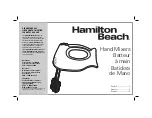
19
English
DMP1616 / DMP1616D
Parametric Equalizers
EQ On/Off Button:
This button can turn the Equalizer
for the currently selected channel on and off.
Reset
: Push the reset button to restore all parameters
back to default.
EQ Band On/Off:
Use these buttons to turn the
corresponding EQ bands on and off. While not named
specifically, these bands can be thought of as the low,
low-mid, high-mid and high frequency bands on your
average 4-band EQ.
EQ Type:
For the first and fourth bands on the EQ, users
can select the type of curve used for the EQ. Band 1
can be swapped between a normal EQ band (PEAK),
low shelf filter (SHELF), and high pass filter (CUT). Band
4 can be selected between an EQ band (PEAK), high
shelf filter (SHELF), and low pass filter (CUT). The Low/
High Pass Filters will cut frequencies above and below
the selected frequencies at 18 dB per octave. High and
Low Shelf filters act similarly, but cut frequencies below
the selected frequency by the preset level determined
by the user.
EQ Parameters:
The EQ offers users the ability to view
or edit various parameters/properties of their EQ bands,
including the Gain (dB), the frequency (Hz/kHz) and the
‘Q’ of the EQ band.
Meters:
Both input and output meters are available for
this process, essentially showing the difference in the
overall signal level after equalization.
Feedback Silencer
Feedback occurs when the sound from your speakers
makes its way back into the mixer through microphones.
The audio look causes a high pitch squeal or screech
that can easily ruin your performance. Feedback can be
removed, however, by reducing or removing the problem
frequencies. With a razor-thin filter, feedback can be
completely removed without affecting your audio what-
so-ever.
The DMP1616 features a 12 filter feedback silencer.
This can operate in 2 different modes: Automatic and
Manual. When set to automatic, the activated filters will
automatically search for and remove feedback. When
set to manual, the user is able to adjust the frequency,
gain and Q of the individual filters.
Parameters:
When the Feedback Silencer is set to
“Manual” it offers users the ability to view or edit various
parameters/properties of their EQ bands, including the
Gain (dB), the frequency (Hz/kHz) and the ‘Q’ of the 12
filters.
Threshold:
Adjusting the threshold will determine
the level of signal required for the automatic feedback
silencer to kick in.
31-band GEQ
Graphic equalizers are fantastic in live setups where you
may need to compensate for room acoustics or other
factors. Include a 31-band graphic equalizer on your
speaker output signals to better refine your live audio.
Frequency bands:
The GEQ’s frequency bands can be
boost or cut by the user. Frequencies are set at fixed
frequencies between 20Hz and 20kHz.
VCA
VCA – or voltage controlled amplifier – allows for multiple
mixes to be controlled together while still maintaining
their respective offset. The VCA offers four groups for
channels to be assigned where each of these individual
groups can have their levels controlled together using
the VCA faders. This is typically helpful in ensuring
things such as vocals or instruments can be controlled
without affecting the mix of audio.
Assign:
When the VCA is selected for a channel on
the DSP page, the channel’s signal can be routed or
assigned to one of four groups shown here. To assign
the group, push the respective button and increase the
respective rotary control. This will determine the level of
the signal that will be sent to this VCA group.
Meter: These meters will show the input level of the
channel as well as the appropriate output level when
after the VCA has been applied.
On:
Activating the on button will apply the VCA to the
appropriate channel.
Fader:
Pushing the fader button will bring up a new
window that features a fader for each of the four VCA
groups. Adjusting these faders will adjust channels in
their respective VCA groups accordingly. As previously
noted, adjusting a VCA group will still allow the channels
to keep the offset between each channel. Each fader also
features an on/off button that will activate and deactivate
the VCA group.
Divider:
I/O with HPF and LPF, 2 or 3-way divider (for
output only).
Crossover
Two and three-way crossovers can be assigned to
output mixes, using two or three output channels in the
process. This menu essentially will allow you to select
the corresponding output mixes in addition to one or two
crossover points, as applicable.
Содержание DMP1616
Страница 1: ...User s Manual Advanced Automatic Matrix Mixer DMP1616 DMP1616D...
Страница 25: ...NOTES...
Страница 26: ...NOTES...
Страница 27: ...NOTES...
Страница 28: ...www asystems sys com...








































